Myanmar (Burma)
Copyright 2011, all rights reserved, by Bob Frazee
[Hot Air Balloon Ride]
[Bus Ride Through the Countryside]
[Small Village]
[Mount Popa]
[Ayeyarwaddy River Cruise ]

Taking a hot air balloon ride is exciting within itself and you should try it some time. My first one was in 1975 when I rode over the Saint Croix Valley in Wisconsin. Silently drifting over the countryside on a still morning in the spring was quite a treat. On our previous trips we have used almost every opportunity to see the country from the air in a hot air balloon. Egypt was the exception. The balloon ride was in the desert floating over the Valley of the Kings outside Luxor and we concluded it would not have had enough to see to make it worth while. We were correct. Everyone who went on the trip was disappointed. If it had gone over Luxor, or the pyramids, we would have had a different attitude.
 Balloon ride over Cappadocia, Turkey Without question our second best ride. The canyon formations were impressive. Picking a ride where you know there is something below - like these geological formations - will always be a good bet. |
 Balloon ride over Serengeti, Tanzania How good this ride will be depends on the presence of wild animals. We saw a few, but if the wilderbeast and zebras had been in migration below it would have been great. We only saw a few hippos in pools of water. The time of year you are in the Serengeti makes all the difference in the world. |
Balloon rides always start at dawn when the air is still so you don't get bounced around. We were picked up in the dark and driven to the launching site. Like polo, ballooning is the sport of kings, and we are treated like royalty.
201 Hot coffee, tea and rolls are awaiting us. |
203 The balloons are carefully laid out on the ground and prepared for the launch. |
204 We will fly in a pack of three balloons with each wicker basket gondola holding 6 to 12 people plus the pilot |
205 While the balloons are being inflated with hot air we are given instructions on how to board the gondola while it sits on the ground. There are foot holes on the side of the basket that are used for getting in - getting out later is another matter. |
206 Are you ready? |
207 The first group is airborne |
208 Our pilot, Ian, pulls the trigger |
209 The gas burners ignite and there is a deafening roar as the flames push hot air into the balloon. Our ride is anything but silent. |
210 And Echo, our balloon, is up, up, and away as it starts it ascent to the heavens |
211 Just in time to watch the sunrise - the same one we saw setting last night as we watched from the roof of the Pyathatgyi pagoda |
212 Balloon rides are best in the early morning at sunrise because there is no wind. |
213 Smoke from the early morning cooking fires hang low in the valley below. |
214 |
215 |
216 |
217 |
218 The air was silent as we drifted toward the river. The smoke from early morning cooking fires hovered in the valleys and between the trees. |
219 |
220 As we passed over the dome our balloon floated toward the river. |
221 People looked up and waved "Good Morning" |
222 Early morning fishermen. |
223 |
224 |
225 |
226 |
227 |
228 |
229 |
230 The Haunted Temple |
231 |
232 |
233 |
234 |
235 |
236 Twin Temples built by father and son. Son built his temple smaller than his father's in honor of his father's stature. Like the pyramids! |
237 |
238 |
239 Our pilot sets a camera up on a swing so he can take a group shot of us in our gondola. |
240 |
241 |
242 |
243 |
244 The Thatbyinyu Temple is the tallest structure in Bagan and still an active monastery. |
245 The Temple was built by King Alaungsithu (1113-1167) in 1144. |
246 The landing zone is spotted |
247 Air is let out of the top of the balloon so it will "slowly" descend to the ground for a "soft, we hope, landing." Notice everyone is looking over the top of the basket.... |
248 What happened to all those people we saw a moment ago? Only the captain is standing up. |
249 When you don't bend like a wet spaghetti noodle anymore getting out is not as easy as it used to be. But we are all smiles. |
250 Champaign all around! |
251 |
252 Cheese and crackers |
253 And of course, souvenir items for sale. |
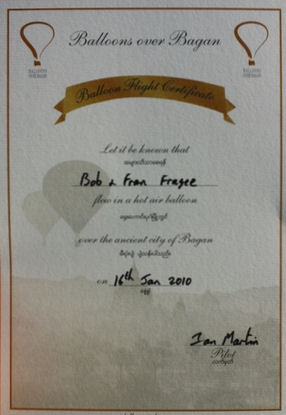

![]()
Ride Through the Countryside
With the balloon experience over our Tour Director, Lennie, tells us we can spend the day on our own in Bagan or he has arranged a special trip for us to Mt. Popa, home of the Nats. This is an optional trip but the additional cost is worth twice the price. Here is our chance to get out and see the Burmese countryside. This side trip is the reason I loved Burma.
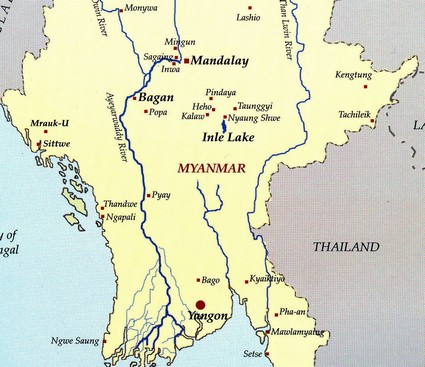 254 Mt. Popa is located to the south east of Bagan and obviously and important site gauging from the fact it is located on this map. |
255 After breakfast we board our private mini-bus and didn't have to use this local transportation where not an inch of sitting or standing space is unoccupied. |
256 At least we were not traveling in a rickety wooden wheeled cart being pulled by this large bull, which was not an uncommon sight. |
257 Men hand carry bundles of straw to their farms. Much of the work done in the country is by hand. |
258 Barefoot boys were off to school carrying their books and tin buckets which held their lunch. |
259 Almost everything is carried to market by hand. Having an ox and cart or motorized vehicle is a real luxury. Notice the ingenious way in which she used palm branches to raise the sides of her baskets so she could carry more produce. |
We often talk about doing something "the old fashioned way" as a symbol of getting "back to the basics" which means paying attention to "doing it right"; to make a quality product rather then relying on gimmicks or fancy machinery. While driving through the countryside we came across this factory which was making peanut oil "the old fashioned way".
260 One Brahma bull, a circular path, and a boy with a stick to encourage the bull, are the source of energy. |
261 A mortar and pestle, made from a tree trunk and log, and a cup to catch the oil are the machinery. It doesn't get more basic. Just add peanuts from the adjacent field and you are in production. |
262 Once the "machinery" is set into operation it doesn't need much tending so the operator can sit back and read a book while riding along. |
263 Like Tom Sawyer, the operator every once in a while manages to snooker some unsuspecting tourist into thinking this is great fun and he gets some help. |
264 You might say it is so easy a caveman can do it. |
265 Not every job looks so easy. |
No one stepped forward to help these women or men.
266 |
267 |
268 To make palm nut liquor you first have to climb to the top of a palm tree. Hanging from your waist are clay pots to collect the sap. |
269 Previously you have tapped the cut flower of the palm tree. The sap from the cut flower has been slowly collected and is now poured into the pots you brought up. |
270 Down you come with the harvest in hand. |
271 The sap is boiled to get rid of the excess water. The natural yeast in the sap causes fermentation needed to get alcohol. The rest of the distilling process takes time but it give you a powerful adult beverage. |
272 We are offered tea and palm sugar candy. |
273 A mother rocks her baby in this cradle. |
274 Taking cloth to market. |
275 Not everyone walks. Look at the load of fodder on the back of this guy's bicycle. |
276 |
277 |
278 Here a second woman deflects the grain to assist in the separation process. |
279 A herd of cattle are driven down the road to pasture as we watched the women work. |

![]()
Walking Tour Through a Small Village
280 We arrived in a village, so small it didn't have a name. When we arrived a local bus pulled into town. |
281The market had a selection of fresh fruit but this is a small village so the selection and quantity is limited: lots of fresh bananas, tomatoes, apple jack fruit and papaya. |
282 Young girl shows us her produce; fresh bananas and a bottle holding the yellow flower from the Champac tree. This flower is sacred to the nats (see below) and placed in the home for the family spirits which guard their homes. |
283 We are taken on a walking tour of the village. It is very primitive; the streets can be distinguished from walking paths only because they are wider, and have visible ruts from ox carts. |
As we walk through the village, which is probably representative of a thousand others in the countryside, we find small fenced in garden plots and laundry hanging out to dry. |
The people take pride in what they have and are very friendly. |
284 The cattle stall is next to the home as is not uncommon in many farming communities. |
285 As was the case everywhere, the people were very friendly and eager to show us their homes. |
286 The homes were built on stilts more to provide a shaded area to relax, allow cool air circulation under the home and for dry storage. |
287 We are invited into the home to view the living quarters. We leave our shoes at the bottom of the stairs as we went up to the living area. |
289 The house was very clean and orderly. Straw mats were the floor covering. There was no need to put glass on the windows. Palm shutters keep out the rain when necessary. This is the porch, note the floor boards are wide apart and the floor is covered with mats which allow circulation from below. |
288 One large room serves as living room. It turns into a bed room when the sleeping mattresses are unrolled. |
Cooking is done outdoors in the yard below. This helps keep the house cooler and the danger of fire is reduced. |
290 Whenever we go to a small town we are always greeted by local officials to show us around. I thought the guy in the red shirt was the mayor. It turned out he was just a friendly villager and the brother of the other man, who turned out to be the school principal. That's as high as the government gets here. |
291 It is customary for us to visit a local school. These woman gathered around as we were told about the facilities. The one on the left is a 9th grade social studies teacher, the middle one is a friend and farmer's wife, and the third woman is a nurse and midwife from the local rural clinic. |
We are told the principle is in charge of 60 teachers and 1200 students who come here from 20 different villages in the surrounding area. Teachers and administrators are assigned by the government to schools in the villages they originally come from. This way they are familiar with the families, the local traditions and naturally have more credibility with the families - The teacher is one of their own and a very respected person.
292 This is the local village's elementary school. |
293 A woman living in the neighborhood sees us and comes over with her baby. She is naturally curious to know why these "strangers" are here. |
302 The local bus is loaded and leaves town. |
303 We are not far behind as we board our mini-bus and headed to Mount Popa. |


295 Before heading to the mountain we go to the Popa Mountain Resort for lunch. We leave the farm lands below and wind up a narrow road leading us into the hill country which is home to the teak forests. |
296 Teak carvings of elephants are everywhere. Up to this time we had not seen anything about elephants. They are used to haul teak logs through the forest in the high country which we had now entered. |
297 Notice the three dimensional character of this carving with the elephants in the background. Very nicely done. |
298 |
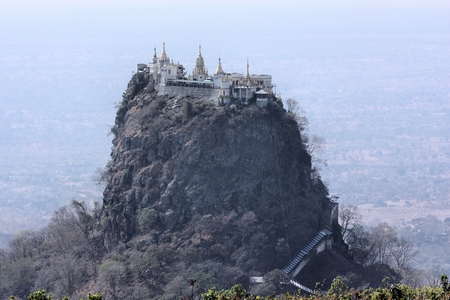 299 As we eat lunch on the patio we have a view of Taung Kalat Monastery, built on Popa Crest. Notice the stairway leading to the top of the mountain, there are over 777 steps to the top. I wonder to myself, "Will we get a chance to climb to the top?" |
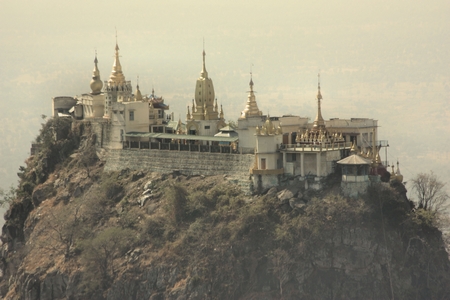 300 |
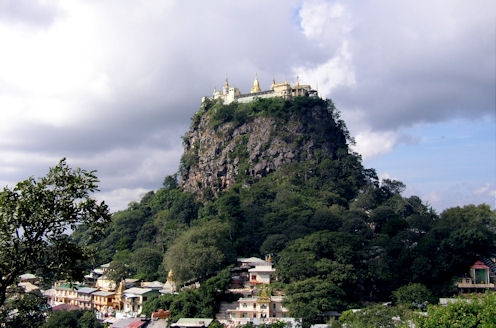
The legends of the Nats are just as fascinating to study as was my trying to understand Buddhism and Hinduism. Everyone in Burma knows the stories as well as I know the stories about Paul Bunyan and Babe the Blue Ox. One of the legends tells us that Min Mahagiri and his sister, Saw Me Ya Mahagiri were from the kingdom of Tagaung. The King of Tagaung was afraid of Min Mahagiri and by deceit and deception captured him and had him burned alive on a Champac tree (thus the sacred nature of the flower). His sister jumped into the fire in an attempt to save him. The only thing she could save was his head and she died of her burns. The King of Tagaung cut down the tree and threw it into the Irrawaddy river where it floated down to Bagan. Their spirits asked King Thinligyaung (344-387) for refuge and their wish was granted and they were enshrined on Mount Popa.
304 When we arrived at the base of Mount Popa we found the village over-run with monkeys. |
305 Lennie, our guide, explains the Nat beliefs and we try hard to understand this unique culture. |
306 We are taken to a shrine for the Nats and we are just overwhelmed. |
307 I listen carefully but I can't remember who is who. I am on information overload. |
308 Me Wunna with her sons Min Gyi and Min Lay. |
309 Maung Po Tu was killed by a tiger. |
310 Although this is a shrine to the nats A shrine showing Buddha teaching his students under a tree is not inconsistent. |
311 We start up the 777 steps to the Monastery and of course there are many gifts to the gods that we can buy. |
312 To get to the monastery is so important that the sick and lame will hire someone to carry them up. We are neither but, a decision is made that we don't have time, so we head for our bus. This bus of pilgrims is just leaving. |
313 Merchants are everywhere. |
You are urged to learn more about the exciting
lives and tragic deaths of the
Nats.
I am already sorry I had not taken more pictures.
If you have some you want to share just send them to me.
I have worked really hard on this so humor me and take a look.
But, this was not our ship. |
We are traveling "like the locals". When we arrived at the river's edge and boarded our boat we were surrounded by teenage girls and small boys selling all sorts of memories to take home. We used the usual defensive maneuver "Wait until we get back". |
And, they all waited. |
The family uses the river to wash clothes and themselves. |
A load of laundry |
Many people live on sand banks on the other side of the river where land is cheap but also subject to flooding during high water. |
Unique drive shafts on the boats. People living in boat houses is also common. |
After a long day we were treated to some appetizers. Lennie had purchased some fruit in the small village: Guava, apple jack fruit and papaya. |
Our "cruise ship" was quite plain. |
Fisherman waiting for a catch. |
As the sun set we headed for shore and were greeted the young kids selling trinkets. The items were cheap and we wondered how they could sell these items at prices far below the rates in the roadside shops. couldn't resist the prices but in the dark we didn't get a chance to really inspect the quality of what we were buying. |

Lets go to Mandalay (yet to be constructed )

Write to![]() Belli for more information about our travels .
Belli for more information about our travels .
